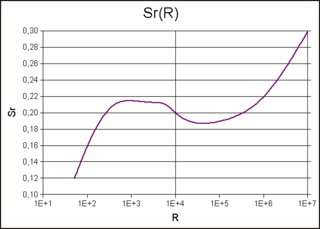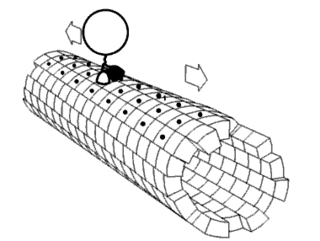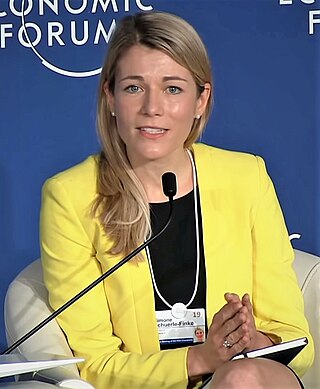
In dimensional analysis, the Strouhal number is a dimensionless number describing oscillating flow mechanisms. The parameter is named after Vincenc Strouhal, a Czech physicist who experimented in 1878 with wires experiencing vortex shedding and singing in the wind. The Strouhal number is an integral part of the fundamentals of fluid mechanics.

The University of Waterloo is a public research university with a main campus in Waterloo, Ontario, Canada. The main campus is on 404 hectares of land adjacent to uptown Waterloo and Waterloo Park. The university also operates three satellite campuses and four affiliated university colleges. The university offers academic programs administered by six faculties and thirteen faculty-based schools. Waterloo operates the largest post-secondary co-operative education program in the world, with over 20,000 undergraduate students enrolled in the university's co-op program. Waterloo is a member of the U15, a group of research-intensive universities in Canada.

Microbotics is the field of miniature robotics, in particular mobile robots with characteristic dimensions less than 1 mm. The term can also be used for robots capable of handling micrometer size components.
An actuator is a component of a machine that produces force, torque, or displacement, when an electrical, pneumatic or hydraulic input is supplied to it in a system. The effect is usually produced in a controlled way. An actuator translates such an input signal into the required form of mechanical energy. It is a type of transducer. In simple terms, it is a "mover".

Fluid power is the use of fluids under pressure to generate, control, and transmit power. Fluid power is conventionally subdivided into hydraulics and pneumatics. Although steam is also a fluid, steam power is usually classified separately from fluid power. Compressed-air and water-pressure systems were once used to transmit power from a central source to industrial users over extended geographic areas; fluid power systems today are usually within a single building or mobile machine.

Nanoid robotics, or for short, nanorobotics or nanobotics, is an emerging technology field creating machines or robots, which are called nanorobots or simply nanobots, whose components are at or near the scale of a nanometer. More specifically, nanorobotics refers to the nanotechnology engineering discipline of designing and building nanorobots with devices ranging in size from 0.1 to 10 micrometres and constructed of nanoscale or molecular components. The terms nanobot, nanoid, nanite, nanomachine and nanomite have also been used to describe such devices currently under research and development.

Swarm robotics is the study of how to design independent systems of robots without centralized control. The emerging swarming behavior of robotic swarms is created through the interactions between individual robots and the environment. This idea emerged on the field of artificial swarm intelligence, as well as the studies of insects, ants and other fields in nature, where swarm behavior occurs.

Metin Sitti is the Director of the Physical Intelligence Department at the Max Planck Institute for Intelligent Systems in Stuttgart, which he founded in 2014. He is also a Professor in the Department of Information Technology and Electrical Engineering at ETH Zurich, a Professor at the School of Medicine and College of Engineering at Koç University and co-founder of Setex Technologies Inc. based in Pittsburgh, USA.
The Camcon binary actuator is an electronically-controlled electromagnetic actuation device that physically moves in between 2 stable states. Unlike a solenoid the binary actuator technology (BAT) only uses energy when switching in between states. It does not require a constant current running through it.
The Institute of Robotics and Intelligent Systems (IRIS) is part of the ETH Zurich, Switzerland. It replaced the existing Institute of Robotics, of the ETH Zurich in October 2002, when Prof. Bradley J. Nelson moved from the University of Minnesota, United States, to ETH Zurich, and succeeded the Prof. Dr. Gerhard Schweitzer.

The Faculty of Engineering is one of six faculties at the University of Waterloo in Waterloo, Ontario, Canada. It has 8,698 undergraduate students, 2176 graduate students, 334 faculty and 52,750 alumni making it the largest engineering school in Canada with external research funding from 195 Canadian and international partners exceeding $86.8 million. Ranked among the top 50 engineering schools in the world, the faculty of engineering houses eight academic units and offers 15 bachelor's degree programs in a variety of disciplines.

Magnetic levitation (maglev) or magnetic suspension is a method by which an object is suspended with no support other than magnetic fields. Magnetic force is used to counteract the effects of the gravitational force and any other forces.

Bio-inspired robotic locomotion is a subcategory of bio-inspired design. It is about learning concepts from nature and applying them to the design of real-world engineered systems. More specifically, this field is about making robots that are inspired by biological systems, including Biomimicry. Biomimicry is copying from nature while bio-inspired design is learning from nature and making a mechanism that is simpler and more effective than the system observed in nature. Biomimicry has led to the development of a different branch of robotics called soft robotics. The biological systems have been optimized for specific tasks according to their habitat. However, they are multifunctional and are not designed for only one specific functionality. Bio-inspired robotics is about studying biological systems, and looking for the mechanisms that may solve a problem in the engineering field. The designer should then try to simplify and enhance that mechanism for the specific task of interest. Bio-inspired roboticists are usually interested in biosensors, bioactuators, or biomaterials. Most of the robots have some type of locomotion system. Thus, in this article different modes of animal locomotion and few examples of the corresponding bio-inspired robots are introduced.

Jong-Oh Park is a South Korean robotics scholar. He is President of the Korea Institute of Medical Microrobotics and Robot Research Initiative. He joined the faculty of the school of Mechanical System Engineering at the Chonnam National University in South Korea, and presently serves as an executive board member at the International Federation of Robotics (IFR). He has twice received the Scientist of The Year Prize from the Korea Science Reporters Association, and is also the recipient of the IFR's Golden Robot Award, among many other honours. He has also successfully commercialized several robotic systems for medical and industrial applications.

Robot Research Initiative (RRI) is a research institute dedicated to advanced robotics research. It is an affiliated organization of Chonnam National University in Gwangju, Republic of Korea. Prof. Jong Oh Park moved from the Korea Institute of Science and Technology to Chonnam National University in early 2005 and established RRI in March 2008, where he is still actively in charge. RRI is currently a leading institute in the medical robotics field, especially in the area of biomedical micro/nano robotics. RRI is one of the largest institutions among university robotics laboratories in Korea and competes globally.
Bradley James Nelson is an American roboticist and entrepreneur. He has been the Professor of Robotics and Intelligent Systems at ETH Zurich since 2002 and is known for his research in microrobotics, nanorobotics, and medical robotics.
Peer Fischer is a German robotics researcher, specializing in biological nanorobotics.

Simone Schürle-Finke is a German biomedical engineer, assistant professor, and Principal Investigator for the Responsive Biomedical Systems Laboratory in Switzerland. Schürle is a pioneer in nanorobotic and magnetic servoing technologies.

A biohybrid microswimmer also known as biohybrid nanorobot, can be defined as a microswimmer that consist of both biological and artificial constituents, for instance, one or several living microorganisms attached to one or various synthetic parts.

A microswimmer is a microscopic object with the ability to move in a fluid environment. Natural microswimmers are found everywhere in the natural world as biological microorganisms, such as bacteria, archaea, protists, sperm and microanimals. Since the turn of the millennium there has been increasing interest in manufacturing synthetic and biohybrid microswimmers. Although only two decades have passed since their emergence, they have already shown promise for various biomedical and environmental applications.














